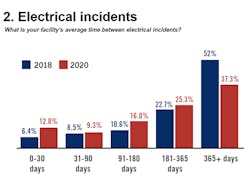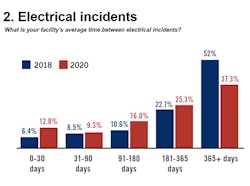Q: Who needs lockout/tagout training? A: Everyone
John Garbarino, Commercial and Industrial Sr. Platform Product Manager for Leviton Mfg., is leading the development of Leviton’s Inform Intelligent Platform, providing real-time operational data from Leviton products to improve safety, efficiency and productivity in industrial and commercial environments. During the Q&A portion of the webinar, “Electrical Safety Survey Results: Is Your Plant up to Code?” Garbarino provided critical information on how to keep your plant safe.
PS: Which employees need lockout/tagout training, and how often would you recommend that training be provided?
JG: The short answer to that is, everyone needs lockout/tagout training. The question is, to what level? When you look at NFPA-70E, there's people who are considered qualified persons who are really the people who are responsible for providing those lockout/tagout functions, and they need to be the most knowledgeable about the equipment that they're working on. In terms of how do I lock it out and tag it out, what are the actual dangers involved with working in and around the equipment?
Certainly, they need the most detailed training. But you also need to train anybody that happens to be working in the vicinity, even if they have nothing to do with that piece of equipment. So if there happens to be a piece of equipment that's next to an administrative office area, the administrative people need to at least be aware of the potential dangers of the electrical equipment in that area. They don't need to know how to fix them or maintain them, but they need to be aware of the actual dangers associated with the equipment, and the risks and challenges.
Everybody needs some education, but clearly, people responsible for maintaining the equipment and administering the programs need to be trained quite often, and in detail.
OSHA and NFPA don't put a specific timeline on that, necessarily: it's more event-driven. An operator is trained on the safety procedures for a specific piece of equipment. If something changes about that equipment, in terms of the physical operation, retraining is required. If there was any kind of change in the way operators need to use it, retraining is required. So, if there's inspections that happen that show there's problems with the way it's been operating, then retraining is required. So it's more event-driven than time-driven.
PS: Is the lockout/tagout procedure required for cord and plug connected equipment?
JG: That actually comes up quite a bit. Because most people think, if my piece of equipment is just connected to the power with a plug and I unplug it, that's obviously de-energized so I don't really need to do anything more. The answer to that is, if that plug is under the exclusive control of the person who's doing the maintenance, the person who's going to be at risk, then there's no problem. However, if somebody else can come along and plug it back in not knowing anything, then you have to have a way of locking that plug out, or tagging that out, to notify people do not plug this back in, because somebody may be working on the piece of equipment.
PS: Do I have to use GFCIs for all receptacles on job sites?
JG: Yes. As a matter of fact, it's specifically written that all 125-volt, 15-, 20- and 30-amp receptacles must be GFCI protected. There's a second part of article 590 in the NEC, 590.6B, which says that all other receptacles, besides the ones specified for 15-, 20-, 30-amp and for 125-volt, must also have GFCI protection. Part of the reason they separate those out, is because the box mount receptacles for 125 volts are readily accessible. For the other voltages, you need to provide protection some other way, because there's probably not a box mount receptacle available, so you need some sort of either line type GFCI or something else.


